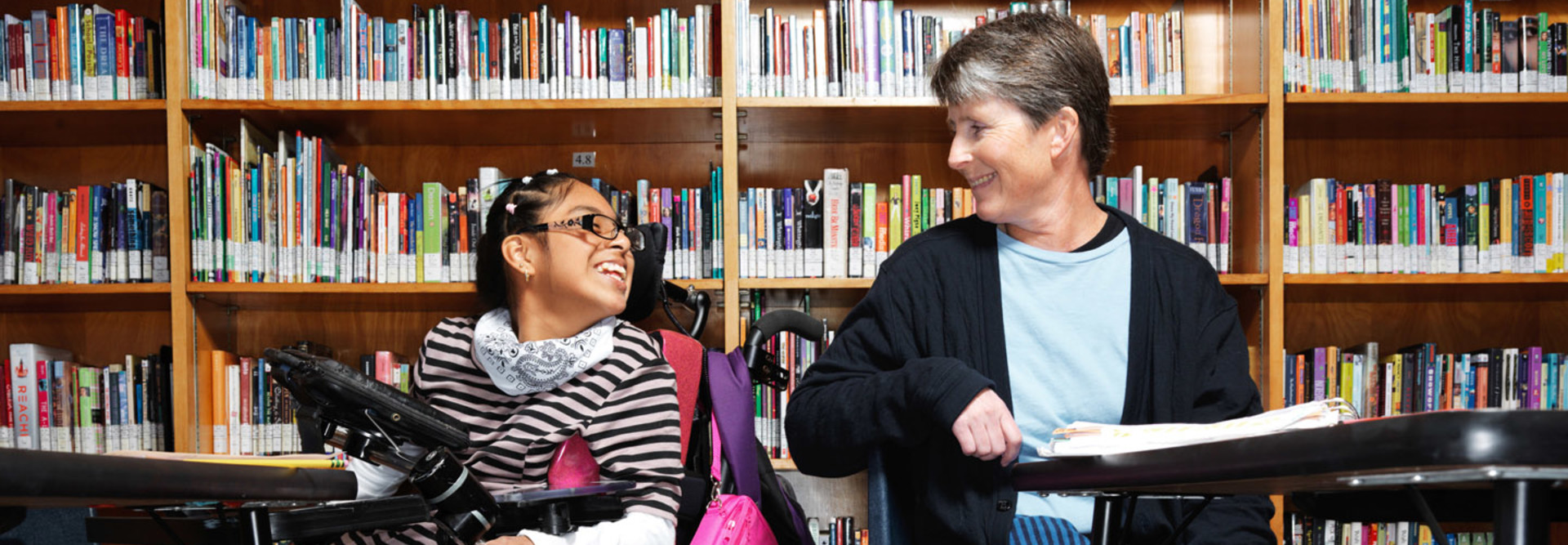Meeting the Tech Needs of Disabled Students
At Pajaro Valley Unified School District, a 7th-grade student with cerebral palsy had been enthusiastically participating in her class’s online reading assessment program using the same tablet computer as all middle school students. But because her physical issues caused her eyes to leave the page of the book she was reading and lose her place, she continually tested well below grade level on reading comprehension.
So Shannon McCord, an assistive technology specialist and volunteer liaison in the Watsonville, Calif., district’s Technology Services Department, worked to help the girl improve her scores. She wanted to rely on as much common, everyday classroom technology as possible — but was prepared to innovate and customize where necessary.
“I came up with a solution so that she could listen to the text, but I also didn’t want to take the text away from her,” McCord recalls.
McCord provided the student with an iPod device and a Bookshare account but also tweaked her tablet’s browser settings to enlarge the print size and add more conducive fonts and background colors. With this setup, the student continues to read the text in a reading application on her tablet (or in a book at home) while at the same time listening to the text.
“That made all the difference in the world in terms of allowing her to hold or get back to her place on the page,” McCord says. “And in just one month, she went from testing at the 3rd-grade level to the 6th grade in reading comprehension.”
Versatile Networks Help Accomodate Everyone
The convergence of mainstream consumer technologies and universal access has made it a lot easier for schools to effectively and successfully accommodate students with disabilities and other special education needs in the classroom, says Tim Landeck, director of technology services at Pajaro Valley USD.
But, he’s quick to add, that doesn’t mean an investment in a cutting-edge IT infrastructure will result in a one-size-fits-all teaching and learning environment for all students.
Percentage of K–12 students in the United States who are formally diagnosed with a learning disability
SOURCE: National Center for Learning Disabilities, “The State of Learning Disabilities,” February 2014
The district, which has 20,300 students enrolled in 33 K–12 school sites, has implemented wired and wireless Cisco Systems networks, purchased thousands of Chromebooks and tablet computers, transitioned to cloud computing via Google Apps for Education and begun building “intelligent classrooms” that boast 70-inch video screens, interactive whiteboards, sound field and amplification systems, and document cameras.
This setup helps students with disabilities achieve a more integrated and positive classroom experience. Students are now able to use smaller, mobile mainstream devices that come equipped with built-in universal access tools such as speech-to-text, word prediction, text enlargement, and adjustable screen colors and contrasts. Or they can use everyday classroom technology in conjunction with customized speech-generating devices, Tobii Technology mobile eye trackers, Livescribe recordable pens, refreshable Braille displays, sound field systems and other specialized assistive technologies.
“The technology we have put in place is definitely an advantage for students with disabilities,” Landeck says. “But we don’t ever assume that just because something is the latest and greatest and works for most of our students — even those with similar disabilities — that it will always be the right or best choice for all students. It still must be very individualized.”
Keeping the Playing Field Level
A downside that can come with the wide rollout of networking and digital technologies in K–12 schools is that it creates a skewed understanding of what accessibility means, says Tracy Gray, managing director of PowerUp What Works at the American Institutes for Research, which works to improve educational achievement for students with disabilities.
“We sometimes hear, ‘Oh, every kid in the class, the school and the district has a device so we can check off the issue of accessibility,’ or ‘It’s online, so, by definition, it’s accessible to everyone,’ ” she says. “But it doesn’t matter how much technology you have or how great it is. It still comes down to taking the time to understand what technology is going to work best for which student under which condition.”
Mika Jensen, assistive technology coordinator for Vail School District in Arizona, agrees.
“It’s easy to think, ‘OK, here’s a Chromebook. You’re good to go.’ Even though the technology is available and even if the student wants to use it and can use it, it doesn’t necessarily mean it’s the absolute best technology fit for that student given the current curriculum and their learning needs. And it needs to be the best fit if the student is going to excel.”
For this reason, true accessibility still begins with the student and developing an effective individual education plan (IEP) before a technology mix is chosen, Jensen says.
“Our special education teams and I look at the students’ current goals and what technology is going to best allow them to achieve those goals,” he says. “And that’s reviewed on an annual basis and sometimes more often because the technology that works best for a student today might not work later in the year, and their needs very often change as they go from one grade level to the next.”
Another key to success is breaking down the barriers between the IT and the assistive technology departments, which typically operate and are funded independently, Gray says.
“They need to work together on a regular basis to make sure that their combined resources are meeting the needs of all the students,” she says.
Open Communication With All Levels for Full Integration
Pajaro Valley USD began tackling this issue 10 years ago when it initiated the Technology Liaison Program, Landeck explains. Through this program, one certified teacher at each school
site volunteers to serve as a conduit for communication with the Technology Services Department. In addition, the Special Education Department also works closely with and provides information to Technology Services.
“It gives us that insight and develops a strong relationship so each department better understands where we’re each coming from, what students at each school are experiencing in the classroom and what mainstream and assistive technologies are available now or will be on the horizon,” Landeck says.
When making any new purchases, whether mainstream or assistive technologies, he and his team work closely with manufacturers and resellers to understand integration and support requirements up front. That way, he says, the district avoids surprises when it comes to implementation and use across schools.
Vail School District addresses this issue by letting Jensen wear two hats. Not only does he oversee assistive technology, but he also serves as the site technology coordinator for the Special Education Department.
“If a student or teacher or behavior specialist has an issue with the technology, it gets handled immediately,” he says, noting that he also sits in on meetings with the IT team. “That’s not the case with other AT coordinators in other districts. They have to put in a technology work order ticket and wait in line. With us, the turnaround time is really quick, and that keeps the playing field level for our students.”








